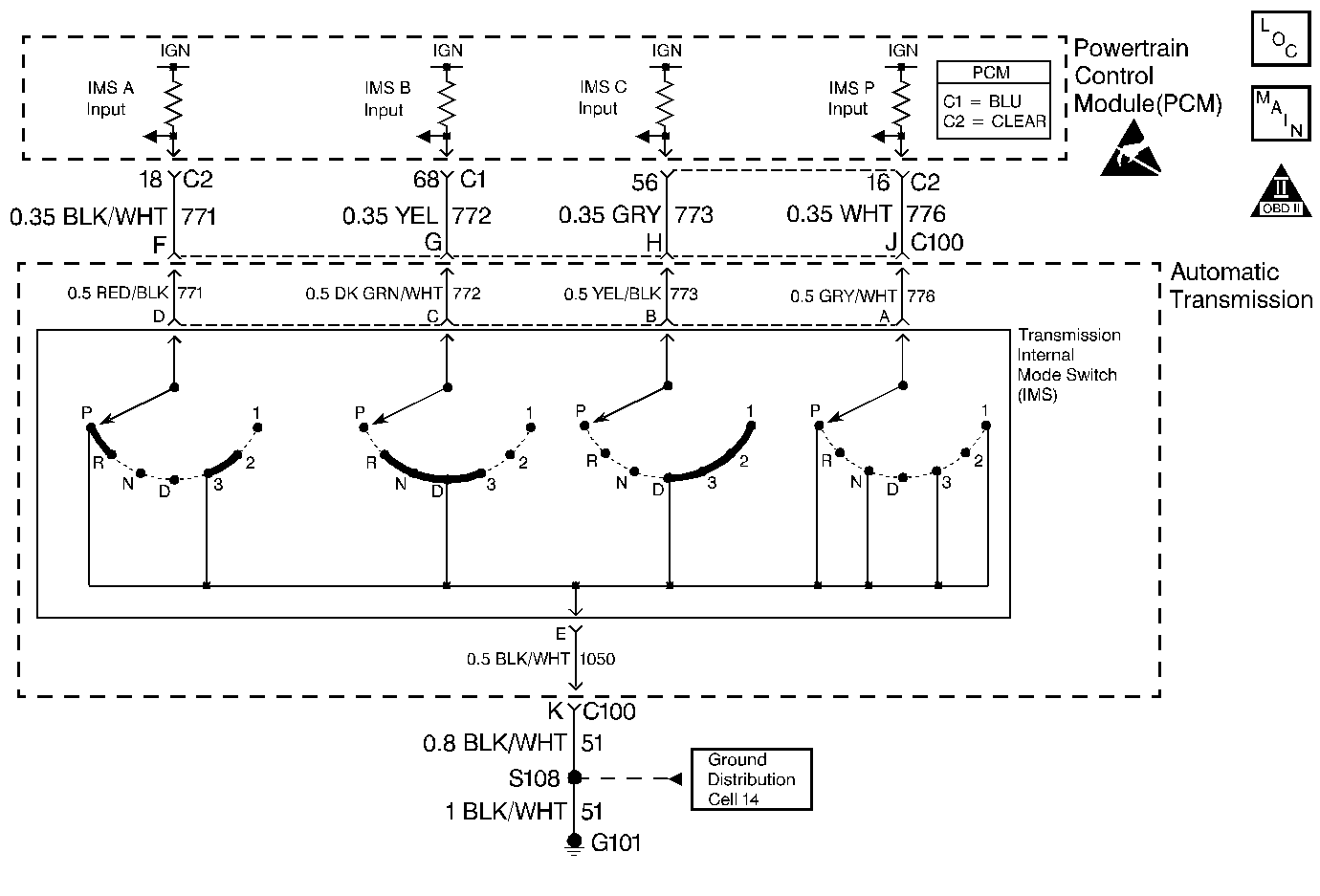
Circuit Description
The transmission internal mode switch (IMS) is a sliding contact switch attached to the selector detent inside the transmission side cover. The four inputs to the PCM from the IMS indicate which position is selected by the transmission selector lever. This information is used for engine controls as well as determining the transmission shift patterns. The input voltage level at the PCM is high (B+) when the IMS is open and low when the switch is closed to ground. The state of each input is available for display on the scan tool. The four input parameters displayed are Input A , Input B, Input C and Input P (Parity).
If the PCM detects a low voltage input from circuit 771 (BLK/WHT) when the transmission selector lever is moved from PARK to D4, then DTC P1820 sets. DTC P1820 is a Type D DTC.
Conditions for Running the DTC
| • | The system voltage is 9-18 volts. |
| • | The engine speed is at least 500 RPM for 5 seconds and not in fuel shutoff. |
Conditions for Setting the DTC
The IMS A Input is continuously low this ignition cycle, and the following conditions occur:
| • | The IMS indicates PARK for 4 seconds, then; |
| • | The IMS indicates transitional position D4-D3 or D3-D2, and; |
| • | Engine torque is 95-407 N·m (70-300 lb ft) with no engine torque defaults for 6 seconds. |
Action Taken When the DTC Sets
| • | The PCM does not illuminate the malfunction indicator lamp (MIL). |
| • | The PCM stores DTC P1820 in PCM history. |
Conditions for Clearing the DTC
| • | A scan tool clears the DTC from the PCM history. |
| • | The PCM clears the DTC from the PCM history if the vehicle completes 40 consecutive warm-up cycles without an emission related diagnostic fault occurring. |
| • | The PCM cancels the DTC default actions when the fault no longer exists and the ignition switch is OFF long enough in order to power down the PCM. |
Diagnostic Aids
| • | Inspect the wiring for faulty electrical connections at the PCM, the transmission 20-way connector, the IMS connector and all other circuit connecting points for the following conditions: |
| - | A backed out terminal |
| - | A damaged terminal |
| - | Reduced terminal tension |
| - | A chafed wire |
| - | A broken wire inside the insulation |
| - | Moisture intrusion |
| - | Corrosion |
| • | When diagnosing for an intermittent short or open, massage the wiring harness while watching the test equipment for a change. |
Test Description
The numbers below refer to the step numbers on the diagnostic table.
-
This step determines if the fault is internal or external to the transmission.
-
This step determines if the engine wiring harness circuit is at fault or the PCM.
-
This step determines if the automatic transmission wiring harness assembly is at fault or the IMS.
-
Because of harsh conditions inside the transmission, repairing the automatic transmission (A/T) wiring harness assembly is not acceptable. It must be replaced if it is damaged in any way.
Step | Action | Value(s) | Yes | No |
|---|---|---|---|---|
1 | Was the Powertrain On-Board Diagnostic (OBD) System Check performed? | -- | Go to Powertrain On Board Diagnostic (OBD) System Check in Engine Controls | |
2 |
Important: Before clearing the DTCs, use the scan tool in order to record the Failure Records for reference. Using the Clear Info function will erase the stored Failure Records from the PCM. Does the state of Mode A change from ON to OFF? | -- | Go to Diagnostic Aids | |
Important: Additional DTCs will set. Does the state of Mode A change from ON to OFF? | -- | |||
Refer to General Electrical Diagnosis in Wiring Systems. Was a condition found? | -- | |||
Refer to General Electrical Diagnosis in Wiring Systems. Was a condition found? | -- | |||
Repair the circuit as necessary. Refer to Wiring Repairs in Wiring Systems. Is the repair complete? | -- | -- | ||
7 | Replace the automatic transmission wiring harness assembly. Refer to Solenoids and Wiring Harness Replacement. Is the replacement complete? | -- | -- | |
8 | Replace the transmission internal mode switch. Refer to Internal Mode Switch Replacement. Is the replacement complete? | -- | -- | |
9 | Replace the PCM. Refer to Powertrain Control Module Replacement/Programming in Engine Controls. Is the replacement complete? | -- | -- | |
10 | Perform the following procedure in order to verify the repair:
Has the test run and passed? | -- | System OK |
